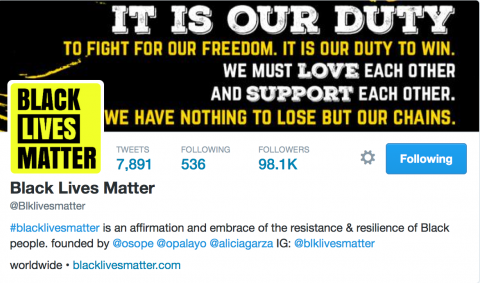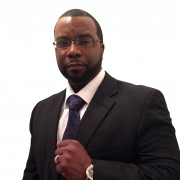
Screenshot of @BlackLivesMatter on Twitter
This blog post originally appeared in The African Methodist Episcopal (AME) Minister's Coalition 4 Redemption
& Justice, a growing group of AME clergy across the country uniting to stand against injustice in the criminal justice system in the United States.
John 19:17-18 NKJ
17 And He, bearing His cross, went out to a place called the Place of a Skull, which is called in Hebrew, Golgotha, 18 where they crucified Him, and two others with Him, one on either side, and Jesus in the center.
We enter this scene with an innocent man hanging from a tree, convicted of associating with thugs, prostitutes, the sick, the poor, and outcasts. The word says that at about three in the afternoon he cried out in a loud voice, “Eli, Eli, lama sabachthani?” “My God, my God, why have you forsaken me?” This passage is one of the most disturbing moments in all of scripture. The Son of God crying out that he is forsaken by his Father, forsaken by society, forsaken by the justice system, forsaken by one of his own disciples and forsaken by his brothers that look just like him. Daily, all over the country black people are slain, and we hear them crying with the same horrifying intensity, Eli, Eli, lama sabachthani?”
I am convinced that Jesus ontologically identifies with African American males because he knew he would be arrested and executed by the state and his own people before his thirty-fifth birthday. The reality of forsakenness and violence is and always has been real for African-Americans. We can argue about who’s at fault, protest police misconduct and debate good cops versus bad cops. We can counter police brutality with black on black violence, but we can’t dispute the validity of black people screaming “black lives matter” in response to the forsakenness we have experienced as the result of violence in this nation; a forsakenness that is experienced uniquely by black people.
Jesus was nailed to a tree in a public execution between two men whom we have been told for centuries were thieves. The Greek word used for thief here often means "robber," but it also means "insurrectionist" or one who insights a violent revolution. Crucifixion was used mainly against rebellious slaves and insurrectionists. It is far more likely that these men were crucified for being leaders in a violent revolution rather than stealing. Remember in Matthew’s gospel, Barabbas was supposed to be crucified instead of Jesus because he was an insurrectionist. The men crucified with Jesus were likely executed because they were violently protesting the Roman government.
So the truth is Jesus did not die the death of a criminal but rather Jesus died the death of a revolutionary. The small but significant nuance and change in perspective and interpretation shed light on how some in society viewed Trayvon Martin, Michael Brown, Sandra Bland, and countless other as criminals while others view them as symbols of the need for radical change.
So the crucifixion scene is not only Jesus taking on the sins of individuals, but Jesus also takes on the sins of society. The crucifixion takes place at the center of revolution, uprising and protest over injustice and occupation. Jesus, although sinless and nonviolent, identifies with the revolutionaries by dying the same violent death. The crucifixion is Jesus being shot dead as a twelve-year-old boy playing with a toy gun. The crucifixion is Jesus being shot dead in Walmart for shopping while black. The crucifixion is Jesus being shot with a hoodie on and walking home with skittles and ice tea. The crucifixion is Jesus being choked by law enforcement while screaming, “I can't breathe.” The crucifixion is Jesus saying, “hands up don't shoot.” The crucifixion is Jesus being sprayed with water hoses and bitten by dogs. The crucifixion is Jesus being beaten on the Edmund Pettus Bridge on Bloody Sunday and being shot at the Loraine Motel and Audubon Ballroom. And yes, the crucifixion is Jesus being gunned down by his own brothers because they have brought into the lie that society has told them for years that they have no worth, no hope, and no future. THE CRUCIFIXION IS JESUS YELLING WITH HIS LAST BREATH “BLACK LIVES MATTER!”
Jesus at this moment is identifying with those who desire justice even if their rap sheet isn’t squeaky clean. Jesus is identifying with those who have been labeled criminals, stereotyped as suspicious, thought of as thugs, antagonized like animals and whose character is assassinated in the media. He identifies with those who don’t have the right to bear their own blackness let alone the right to bear arms.
This Lenten season I pray we look less upon who is doing the crucifying and more upon who is being crucified and why. Anyone who studies the scriptures knows we are less concerned with who crucified Jesus than we are on what crucified Jesus. Our love of violence and the sins of our society that affect us all regardless of color play a part in the daily crucifixion of black life. How can we as a society look upon those who are experiencing violence with compassion? How can we move to be more concerned about someone else’s right to bear life than we are about our right to bear arms? How can we work with police departments recognizing that historical, institutional and media driven racism has clouded all of our view of black men? How can we move away from crucifying each other and towards looking for each others’ resurrection? As the Gospel of John points out, our perspective can radically change when we realize that Jesus was not the only one crucified, but Jesus was certainly at the center.



The views and opinions expressed in this post are those of the author(s) and do not necessarily reflect those of MomsRising.org.
MomsRising.org strongly encourages our readers to post comments in response to blog posts. We value diversity of opinions and perspectives. Our goals for this space are to be educational, thought-provoking, and respectful. So we actively moderate comments and we reserve the right to edit or remove comments that undermine these goals. Thanks!